On the Accuracy of uRANS and LES-Based CFD Modeling Approaches for Rotor and Wake Aerodynamics of the (New) MEXICO Wind Turbine Rotor Phase-III
Abstract
:1. Introduction
2. Numerical Framework
2.1. MEXICO Experiment
2.2. Computational Domain, Boundary Conditions, and Solution Methodology
2.3. Mesh Details
2.4. Governing Equations
2.4.1. uRANS k-ω SST Model
2.4.2. WALE LES Model
2.5. Number of Rotor Revolutions for Steady-State Solution in LES
3. Results and Discussions
3.1. Comparison of Pressure Distribution at 5 Radial Locations
3.2. Velocity Distributions
3.2.1. Axial Traverse
3.2.2. Radial Traverse
3.2.3. Azimuthal Traverse
3.3. Discussion on Near Wake Velocity at Several Downstream Locations
3.4. Discussion on Vorticity
3.5. Comparison of the Computational Resources Required by uRANS and LES
4. Conclusions
- The inception of flow separation for the stall condition of the blade is predicted accurately by the LES approach than by the uRANS approach;
- When λ = 10, the azimuthal traverse of the radial and tangential components of velocity in the inboard region are not predicted more accurately by both of the modeling approaches;
- The fluctuations in the wake when the blade operates at λ = 4.17 are properly captured by the LES approach;
- The wake gets recovered faster in the uRANS approach than in the LES method;
- LES can capture the small-scale vortices shed by the blade much more accurately.
Author Contributions
Funding
Institutional Review Board Statement
Informed Consent Statement
Data Availability Statement
Acknowledgments
Conflicts of Interest
Nomenclature
| Cp | Pressure coefficient |
| D | Rotor diameter (m) |
| Body force per unit mass (N/kg) | |
| k | Turbulence kinetic energy (m2/s2) |
| Ls | Mixing length of sub-grid scales (m) |
| p | Pressure (Pa) |
| P | Pressure on the blade (Pa) |
| P∞ | Atmospheric pressure (Pa) |
| Mean component of pressure term (Pa) | |
| u | Velocity (m/s) |
| Mean velocity along x-axis (m/s) | |
| Mean velocity along y-axis (m/s) | |
| uref | Free-stream air velocity (m/s) |
| Uax | Axial component of velocity (ms−1) |
| Urad | Radial component of velocity (ms−1) |
| Utan | Tangential component of velocity (ms−1) |
| V | Volume (m3) |
| xi | Distance from the origin along the positive x-axis (m) |
| y | Non-dimensional distance normal to the wall |
| Kronecker delta | |
| Stress tensor (N/m2) | |
| ω | Specific dissipation rate (1/s) |
| ε | Turbulent dissipation rate (m2/s3) |
| μ | Dynamic viscosity (Ns/m2) |
| Ψ | Azimuthal angle of the blade (°) |
| ρ | Density (kg/m3) |
| ζn | Non-dimensional vorticity |
| ζ | Local vorticity (s−1) |
| λ | Tip-speed ratio |
Abbreviations
| CFD | Computational Fluid Dynamics |
| uRANS | unsteady Reynolds-Averaged Navier Stokes |
| LES | Large Eddy Simulation |
| MEXICO | Model Experiments In Controlled Conditions |
| NREL | National Renewable Energy Laboratory |
| SST | Shear Stress Transport |
| DES | Detached-Eddy Simulation |
| DDES | Delayed Detached-Eddy Simulation |
| RST | Reynolds Stress Transport |
| FEM | Finite Element Method |
| ALE-VMS | Arbitrary Lagrangian-Eulerian Variational Multiscale |
| HAWTs | Horizontal Axis Wind Turbines |
| WALE | Wall-Adaptive Local Eddy Viscosity |
| SIMPLE | Semi-Implicit Method for Pressure Linked Equations |
| MRF | Multiple Rotating Frame |
| SGS | Sub-Grid Scale |
| DNS | Direct Numerical Simulation |
| MAE | Mean Absolute Error |
| Subscripts | |
| i, j, k | 1,2,3 or x, y, z-directions |
| ax | Axial |
| rad | radial |
| tan | tangential |
References
- Kabir, I.F.S.A.; Ng, E.Y.K. Effect of different atmospheric boundary layers on the wake characteristics of NREL phase VI wind turbine. Renew. Energy 2019, 130, 1185–1197. [Google Scholar] [CrossRef]
- Kabir, I.F.S.A.; Safiyullah, F.; Ng, E.Y.K.; Tam, V.W.Y. New analytical wake models based on artificial intelligence and rivalling the benchmark full-rotor CFD predictions under both uniform and ABL inflows. Energy 2020, 193, 116761. [Google Scholar] [CrossRef]
- Hand, M.M.; Simms, D.A.; Fingersh, L.J.; Jager, D.W.; Cotrell, J.R.; Schreck, S.; Larwood, S.M. Unsteady Aerodynamics Experiment Phase VI: Wind Tunnel Test Configurations and Available Data Campaigns; Technical Report NREL/TP-500-29955; National Renewable Energy Laboratory: Golden, CO, USA, 2001. [Google Scholar]
- Schepers, G.J.; Boorsma, K.; Cho, T.; Gomez-Iradi, S.; Schaffarczyk, P.; Jeromin, A.; Shen, W.Z.; Lutz, T.; Meister, K.; Stoevesandt, B.; et al. Analysis of Mexico Wind Tunnel Measurements: Final Report of IEA Task 29, Mexnext (Phase 1); ECN-E, No. 12-004; Energy Research Center of the Netherlands (ECN): Petten, The Netherlands, 2012. [Google Scholar]
- Boorsma, K.; Schepers, G.J.; Gomez-Iradi, S.; Herraez, I.; Lutz, T.; Weihing, P.; Oggiano, L.; Pirrung, G.; Madsen, H.A.; Shen, W.Z.; et al. Final Report of IEA Wind Task 29 Mexnext (Phase 3); ECN-E-18-003; Energy Research Center of the Netherlands (ECN): Petten, The Netherlands, 2018. [Google Scholar]
- Bechmann, A.; Sørensen, N.N.; Zahle, F. CFD simulations of the MEXICO rotor. Wind Energy 2011, 14, 677–689. [Google Scholar] [CrossRef]
- Sørensen, N.N.; Bechmann, A.; Réthoré, P.-E.; Zahle, F. Near wake Reynolds-averaged Navier-Stokes predictions of the wake behind the MEXICO rotor in axial and yawed flow conditions. Wind Energy 2014, 17, 75–86. [Google Scholar] [CrossRef] [Green Version]
- Sørensen, N.N.; Zahle, F.; Boorsma, K.; Schepers, G. CFD computations of the second round of MEXICO rotor measurements. J. Phys. Conf. Ser. 2016, 753, 022054. [Google Scholar] [CrossRef]
- Shen, W.Z.; Zhu, W.J.; Sørensen, J.N. Actuator line/Navier-Stokes computations for the MEXICO rotor: Comparison with detailed measurements. Wind Energy 2012, 15, 811–825. [Google Scholar] [CrossRef]
- Nilsson, K.; Shen, W.Z.; Sørensen, J.N.; Breton, S.-P.; Ivanell, S. Validation of the actuator line method using near wake measurements of the MEXICO rotor. Wind Energy 2015, 18, 499–514. [Google Scholar] [CrossRef]
- Nathan, J.; Meyer Forsting, A.R.; Troldberg, N.; Masson, C. Comparison of OpenFOAM and EllipSys3D actuator line methods with (NEW) MEXICO results. J. Phys. Conf. Ser. 2017, 854, 12033. [Google Scholar] [CrossRef] [Green Version]
- Guntur, S.; Sørensen, N.N. A study on rotational augmentation using CFD analysis of flow in the inboard region of the MEXICO rotor blades. Wind Energy 2015, 18, 745–756. [Google Scholar] [CrossRef]
- Herráez, I.; Stoevesandt, B.; Peinke, J. Insight into Rotational Effects on a Wind Turbine Blade Using Navier–Stokes Computations. Energies 2014, 7, 6798–6822. [Google Scholar] [CrossRef] [Green Version]
- Carrión, M.; Steijl, R.; Woodgate, M.; Barakos, G.; Munduate, X.; Gomez-Iradi, S. Computational fluid dynamics analysis of the wake behind the MEXICO rotor in axial flow conditions. Wind Energy 2015, 18, 1023–1045. [Google Scholar] [CrossRef]
- Li, L.; Xu, C.; Shi, C.; Han, X.; Shen, W. Investigation of wake characteristics of the MEXICO wind turbine using lattice Boltzmann method. Wind Energy 2021, 24, 116–132. [Google Scholar] [CrossRef]
- Martínez-Tossas, L.A.; Churchfield, M.J.; Leonardi, S. Large eddy simulations of the flow past wind turbines: Actuator line and disk modeling. Wind Energy 2015, 18, 1047–1060. [Google Scholar] [CrossRef]
- Regodeseves, P.G.; Morros, C.S. Unsteady numerical investigation of the full geometry of a horizontal axis wind turbine: Flow through the rotor and wake. Energy 2020, 202, 117674. [Google Scholar] [CrossRef]
- Zhang, Y.; Deng, S.; Wang, X. RANS and DDES simulations of a horizontal-axis wind turbine under stalled flow condition using OpenFOAM. Energy 2019, 167, 1155–1163. [Google Scholar] [CrossRef]
- Amiri, M.M.; Shadman, M.; Estefen, S.F. URANS simulations of a horizontal axis wind turbine under stall condition using Reynolds stress turbulence models. Energy 2020, 213, 118766. [Google Scholar] [CrossRef]
- Hsu, M.-C.; Akkerman, I.; Bazilevs, Y. Finite element simulation of wind turbine aerodynamics: Validation study using NREL Phase VI experiment. Wind Energy 2014, 17, 461–481. [Google Scholar] [CrossRef]
- Mo, J.-O.; Choudhry, A.; Arjomandi, M.; Lee, Y.-H. Large eddy simulation of the wind turbine wake characteristics in the numerical wind tunnel model. J. Wind Eng. Ind. Aerodyn. 2013, 112, 11–24. [Google Scholar] [CrossRef]
- Tsalicoglou, C.; Jafari, S.; Chokani, N.; Abhari, R.S. RANS Computations of MEXICO Rotor in Uniform and Yawed Inflow. J. Eng. Gas Turbines Power 2014, 136, 011202. [Google Scholar] [CrossRef]
- Rodrigues, R.V.; Lengsfeld, C. Development of a Computational System to Improve Wind Farm Layout, Part 1: Model Validation and Near Wake Analysis. Energies 2019, 12, 940. [Google Scholar] [CrossRef] [Green Version]
- Qian, Y.; Zhang, Z.; Wang, T. Comparative Study of the Aerodynamic Performance of the New MEXICO Rotor under Yaw Conditions. Energies 2018, 11, 833. [Google Scholar] [CrossRef] [Green Version]
- Johansen, J.; Sørensen, N.N.; Michelsen, J.A.; Schreck, S. Detached-eddy simulation of flow around the NREL Phase VI blade. Wind Energy 2002, 5, 185–197. [Google Scholar] [CrossRef]
- Kabir, I.F.S.A.; Ng, E.Y.K. Insight into stall delay and computation of 3D sectional aerofoil characteristics of NREL phase VI wind turbine using inverse BEM and improvement in BEM analysis accounting for stall delay effect. Energy 2017, 120, 518–536. [Google Scholar] [CrossRef]
- Thé, J.; Yu, H. A critical review on the simulations of wind turbine aerodynamics focusing on hybrid RANS-LES methods. Energy 2017, 138, 257–289. [Google Scholar] [CrossRef]
- Li, Y.; Paik, K.-J.; Xing, T.; Carrica, P.M. Dynamic overset CFD simulations of wind turbine aerodynamics. Renew. Energy 2012, 37, 285–298. [Google Scholar] [CrossRef]
- Stone, C.; Lynch, C.; Smith, M. Hybrid RANS/LES simulations of a horizontal axis wind turbine. In Proceedings of the 48th AIAA Aerospace Sciences Meeting Including the New Horizons Forum and Aerospace Exposition, Orlando, FL, USA, 4–7 January 2010. [Google Scholar]
- Lynch, C.; Smith, M. Unstructured overset incompressible computational fluid dynamics for unsteady wind turbine simulations. Wind Energy 2013, 16, 1033–1048. [Google Scholar] [CrossRef]
- Wu, Y.-T.; Porté-Agel, F. Atmospheric Turbulence Effects on Wind-Turbine Wakes: An LES Study. Energies 2012, 12, 5340–5362. [Google Scholar] [CrossRef]
- Plaza, B.; Bardera, R.; Visiedo, S. Comparison of BEM and CFD results for MEXICO rotor aerodynamics. J. Wind Eng. Ind. Aerodyn. 2015, 145, 115–122. [Google Scholar] [CrossRef]
- Lienard, C.; Boisard, R. Investigation of the MEXICO rotor aerodynamics in axial flow, including boundary layer transition effects. In Proceedings of the Wind Energy Symposium, AIAA SciTech Forum, Kissimmee, FL, USA, 8–12 January 2018. [Google Scholar]
- Menter, F.R. Zonal two equation k-ω turbulence models for aerodynamic flows. AIAA J. 1993, 93, 2906. [Google Scholar]
- Menter, F.R. Two-equation eddy-viscosity turbulence models for engineering applications. AIAA J. 1994, 32, 1598–1605. [Google Scholar] [CrossRef] [Green Version]
- Simley, E.; Angelou, N.; Mikkelsen, T.; Sjöholm, M.; Mann, J.; Pao, L.Y. Characterization of wind velocities in the upstream induction zone of a wind turbine using scanning continuous-wave lidars. J. Renew. Sustain. Energy 2016, 8, 013301. [Google Scholar] [CrossRef] [Green Version]
- Barthelmie, R.J.; Hansen, K.; Frandsen, S.T.; Rathmann, O.; Schepers, J.G.; Schlez, W.; Phillips, J.; Rados, K.; Zervos, A.; Politis, E.S.; et al. Modelling and measuring flow and wind turbine wakes in large wind farms offshore. Wind Energy 2009, 12, 431–444. [Google Scholar] [CrossRef]
- Jeong, J.; Hussain, F. On the identification of vortex. J. Fluid Mech. 1995, 285, 69–94. [Google Scholar] [CrossRef]

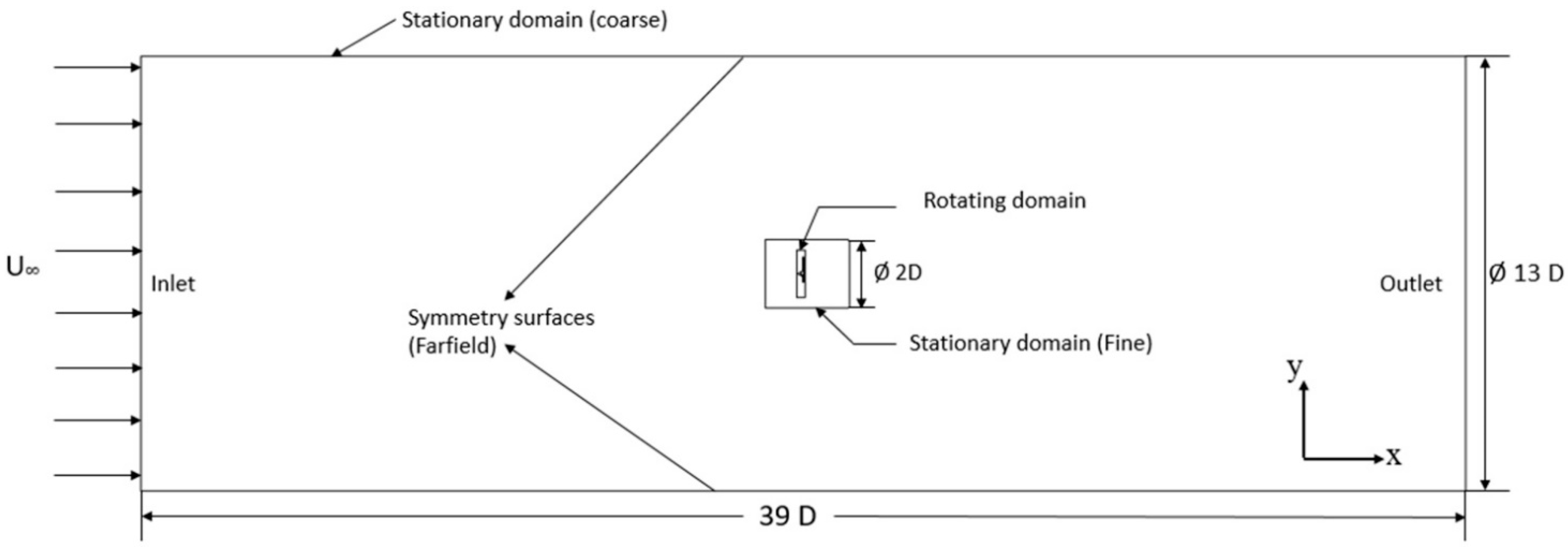
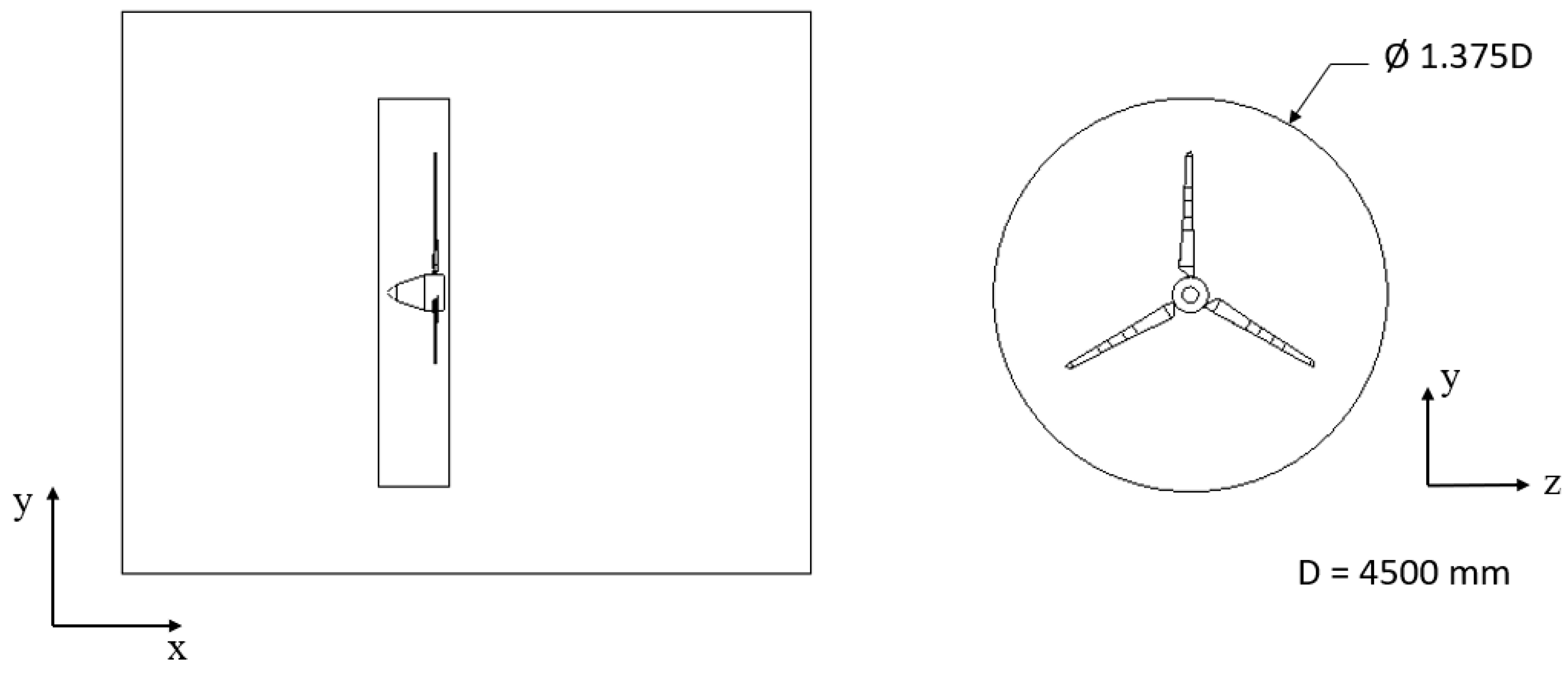
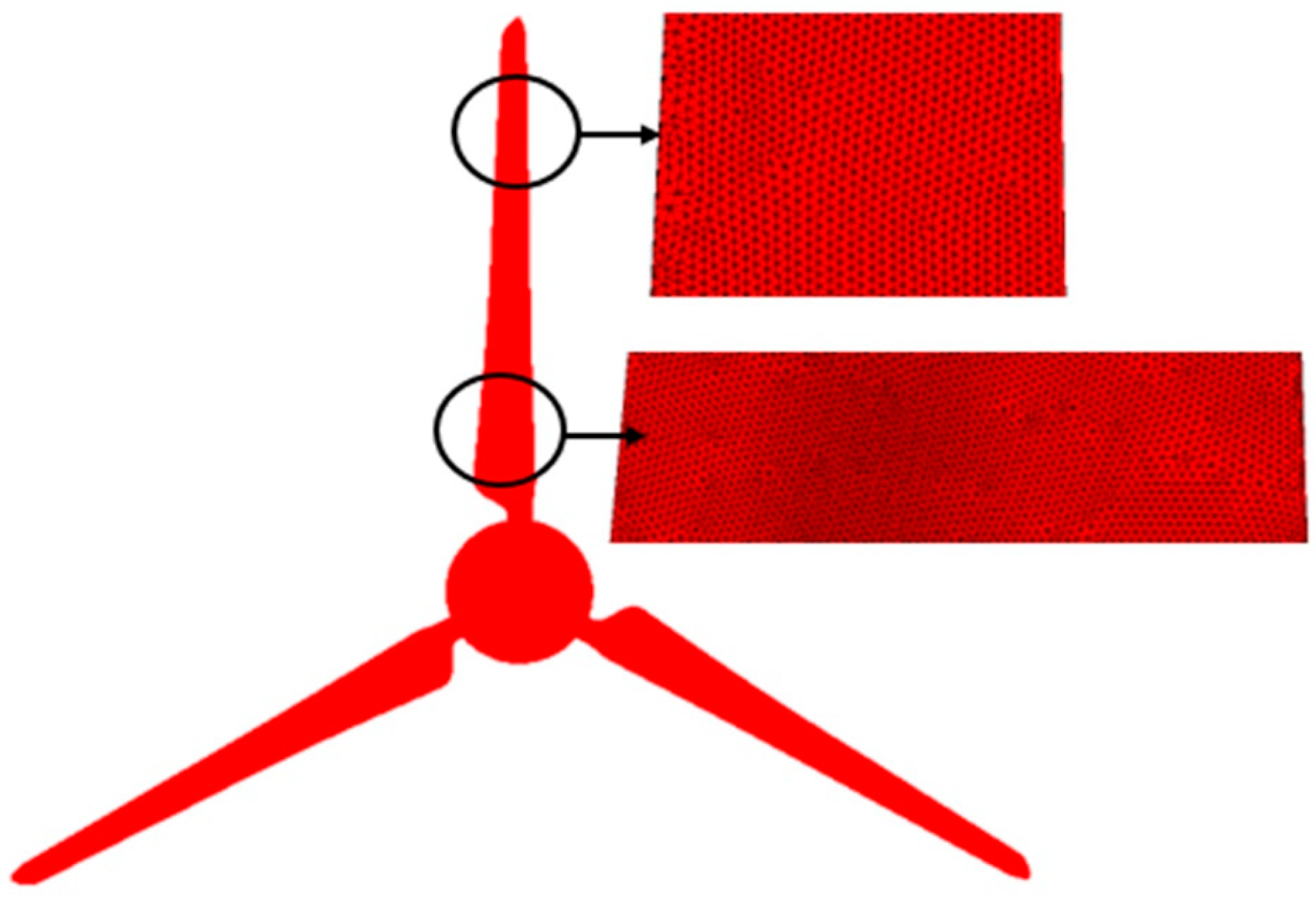

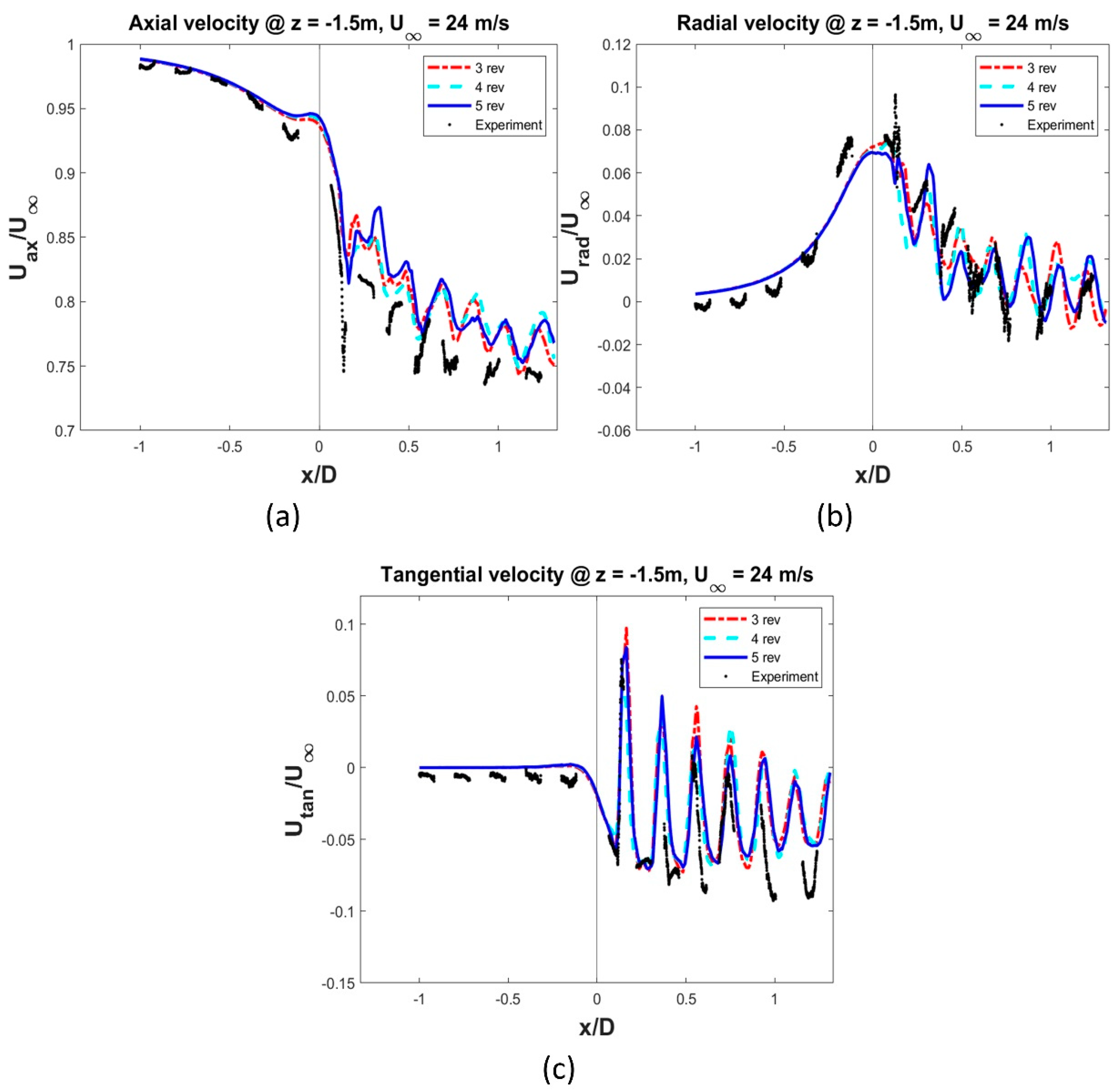
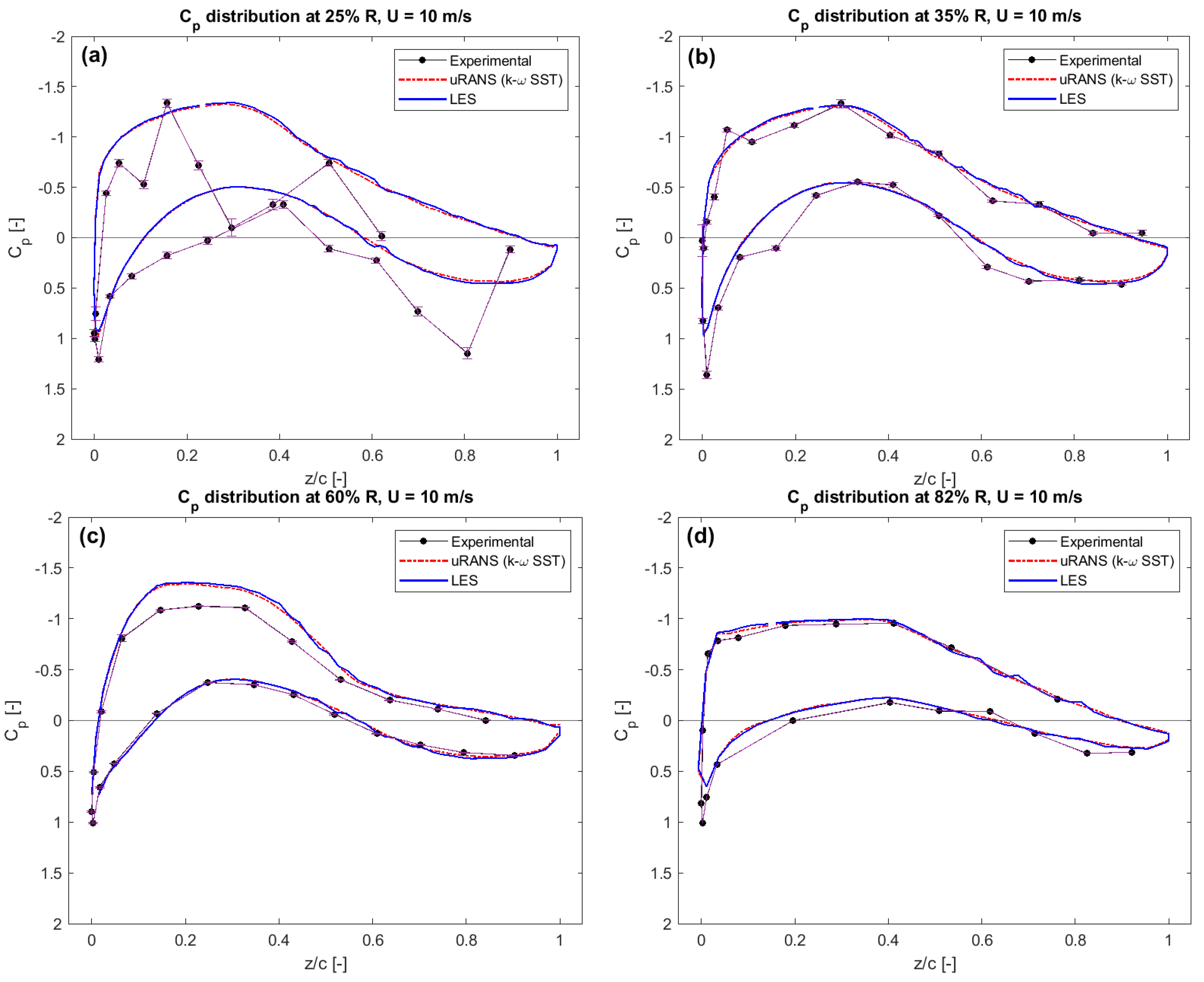

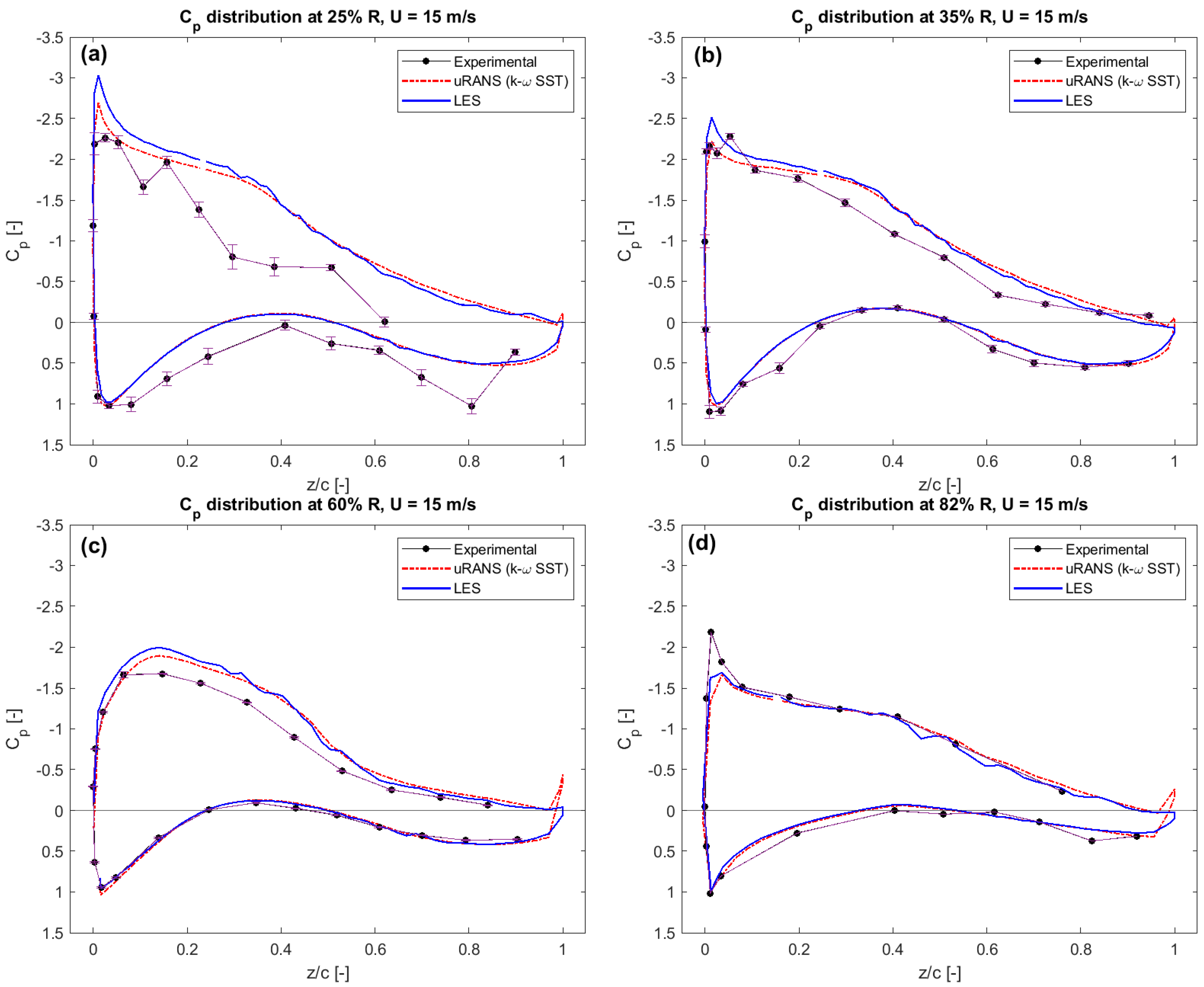
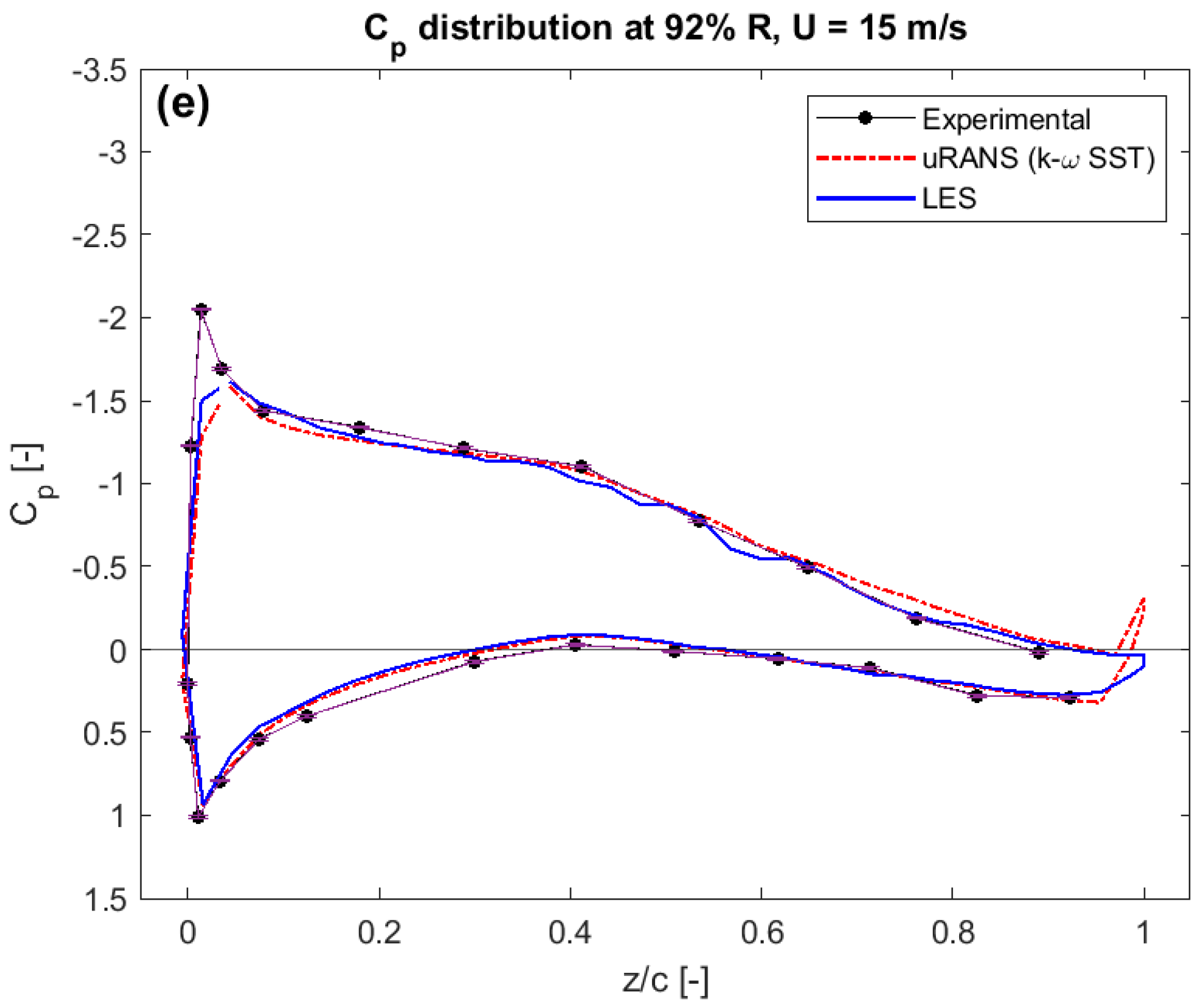

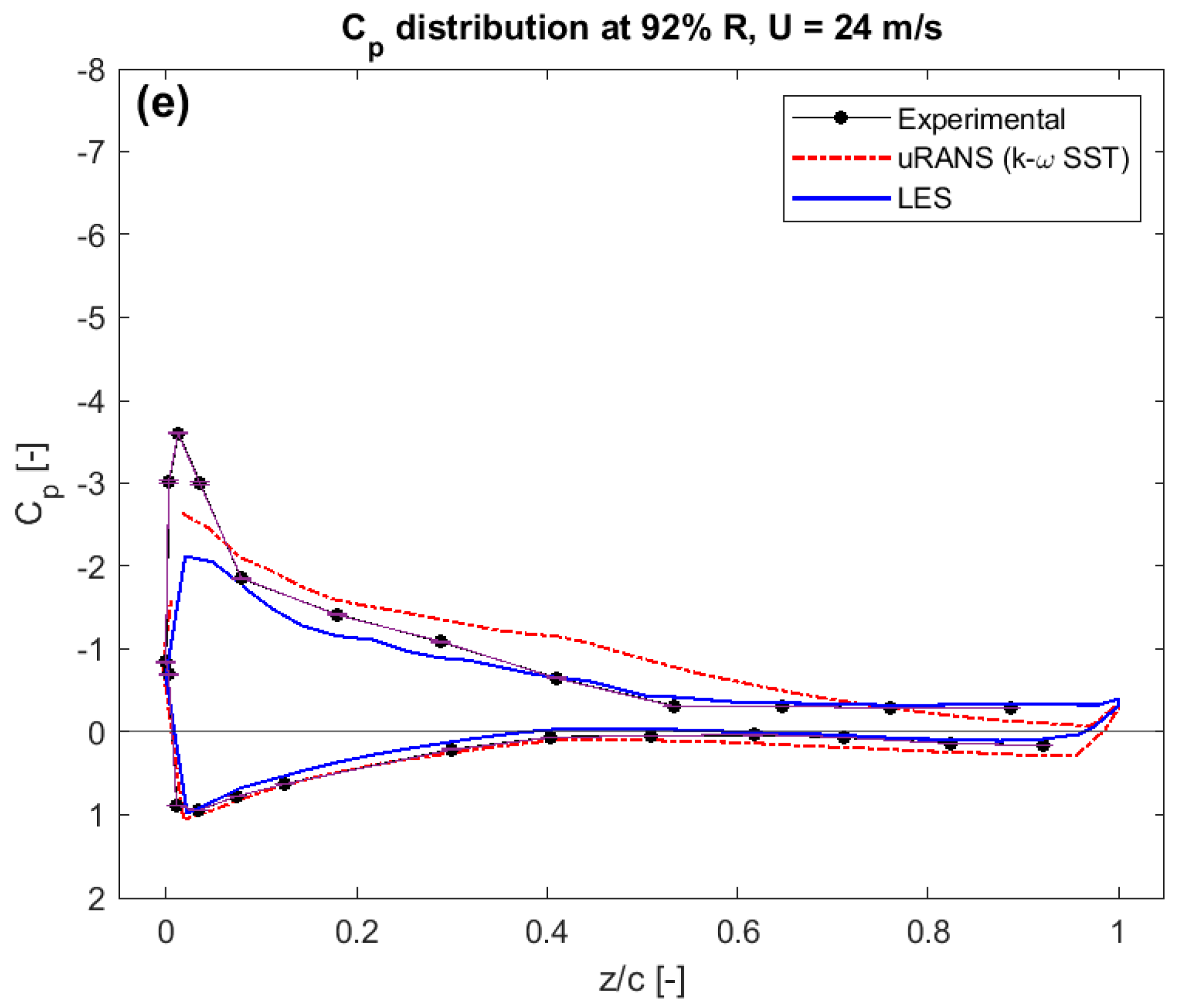

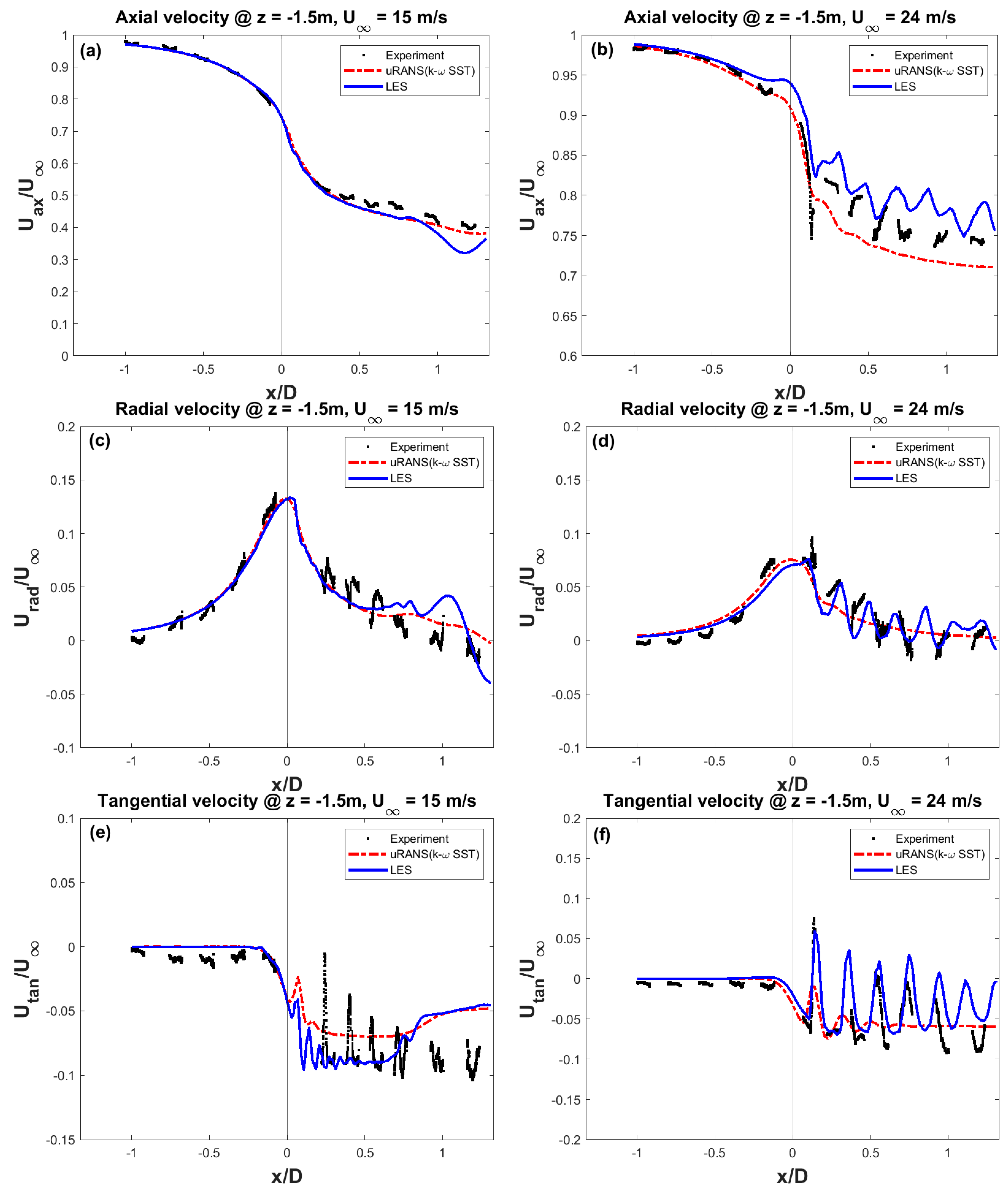
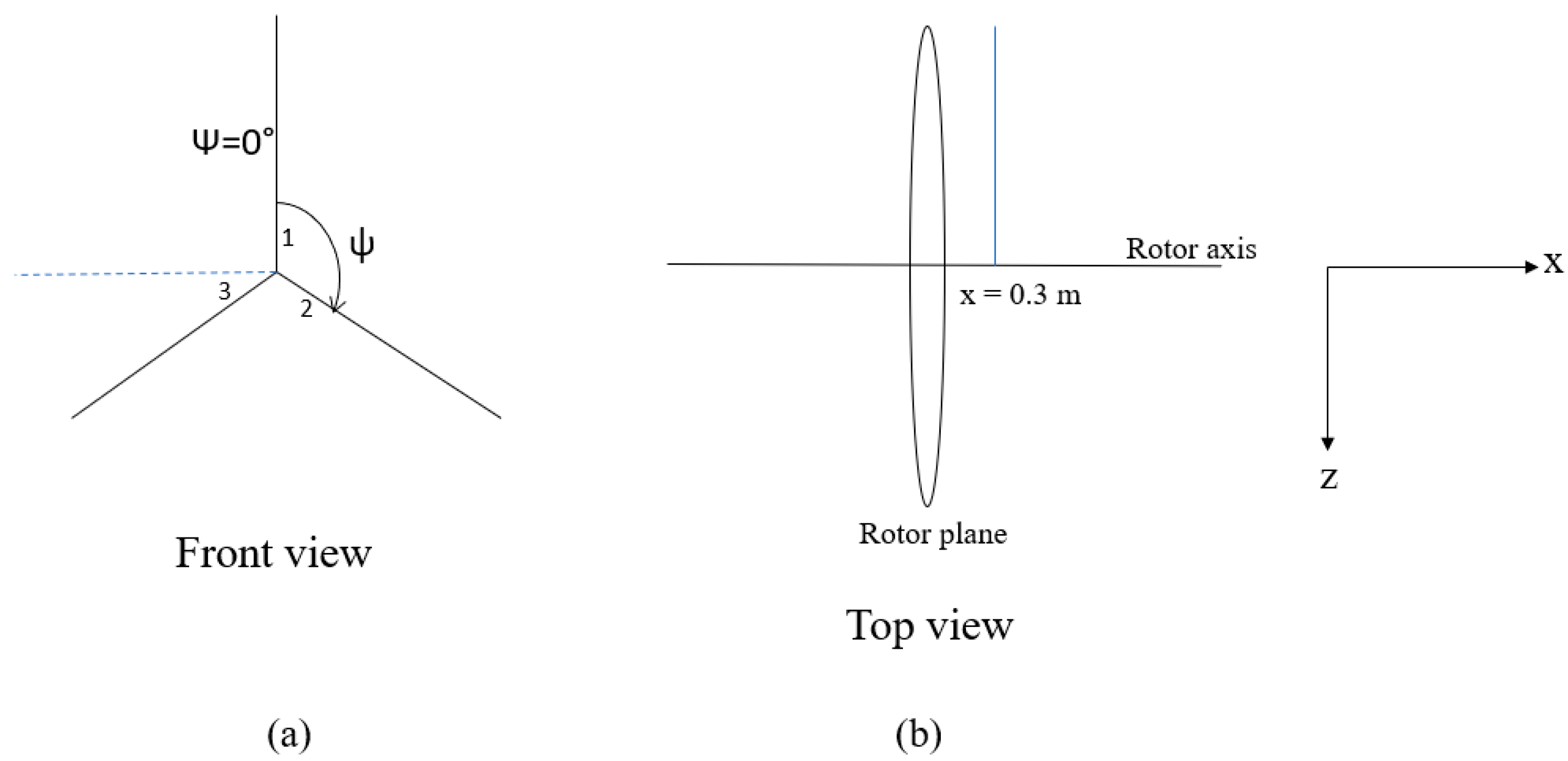

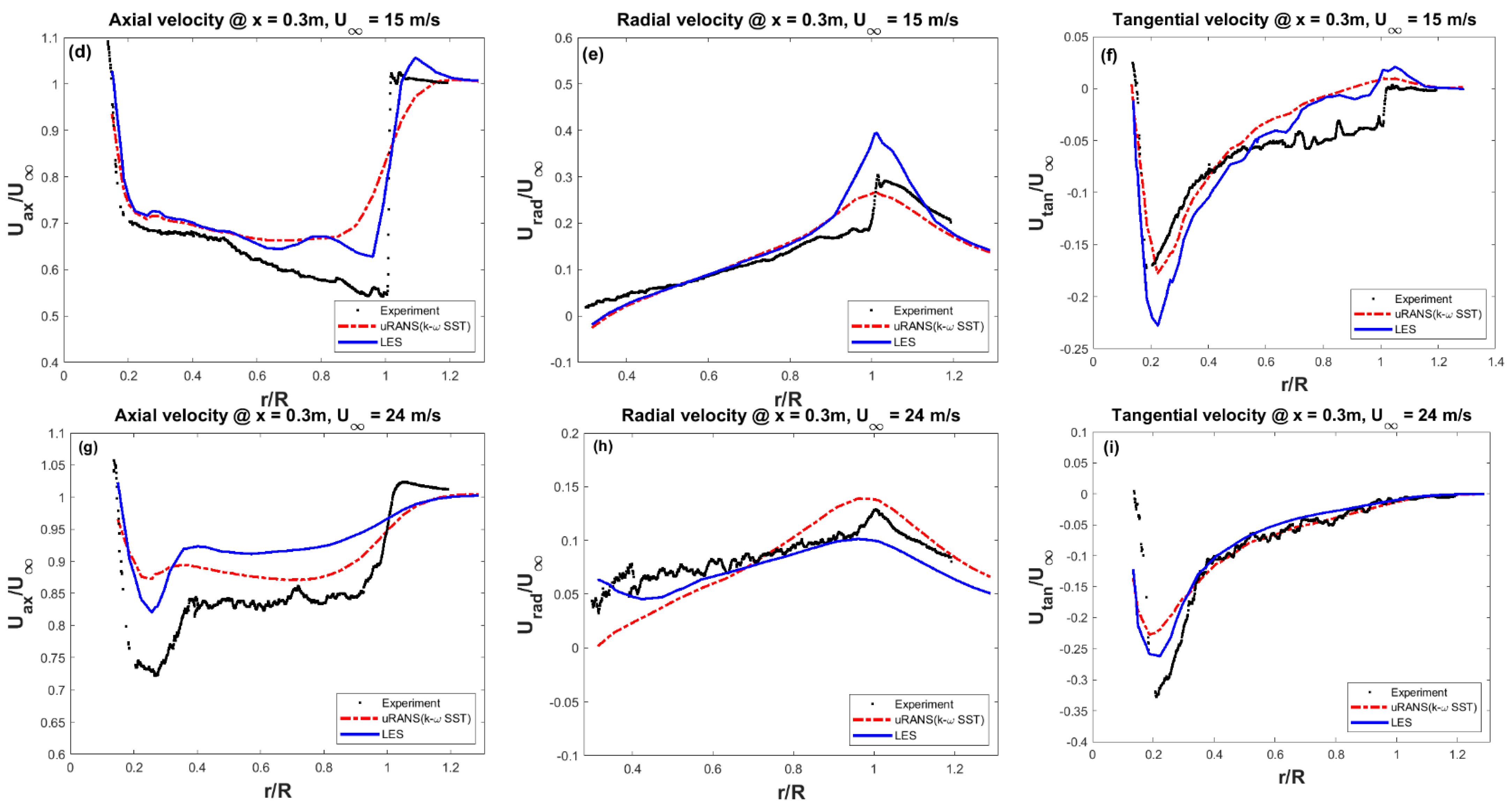
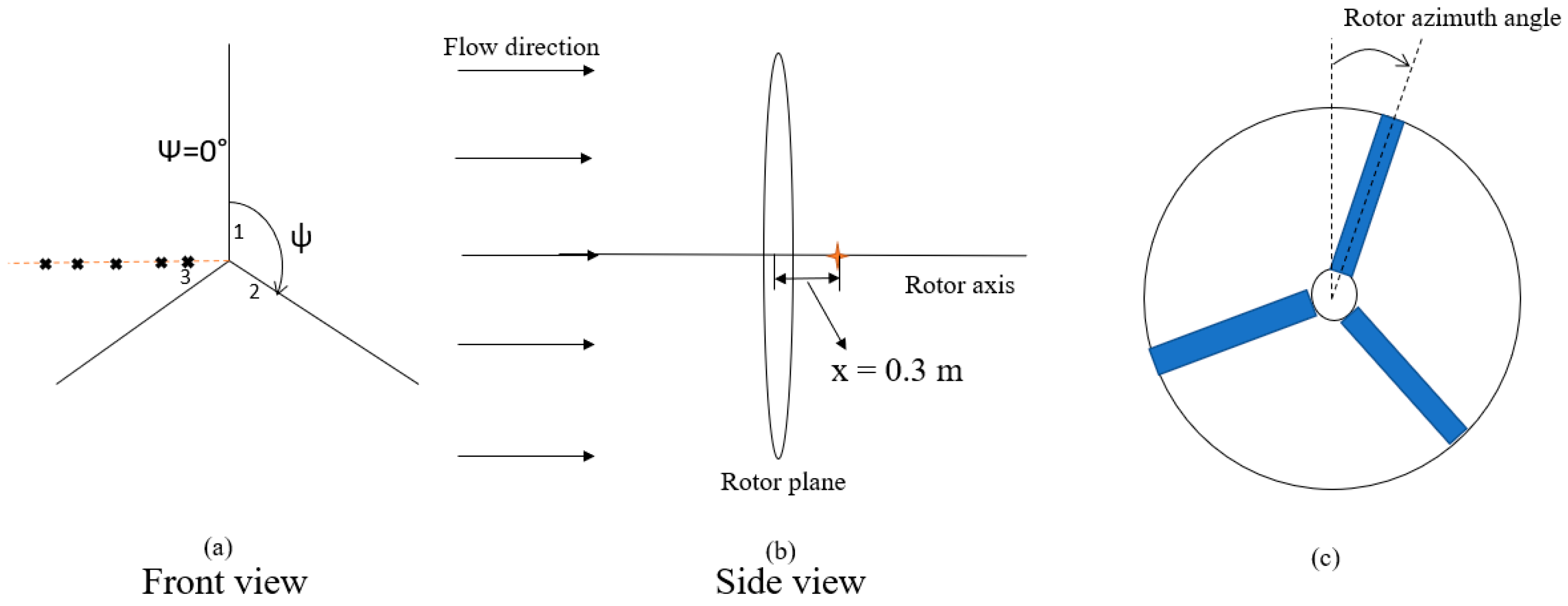
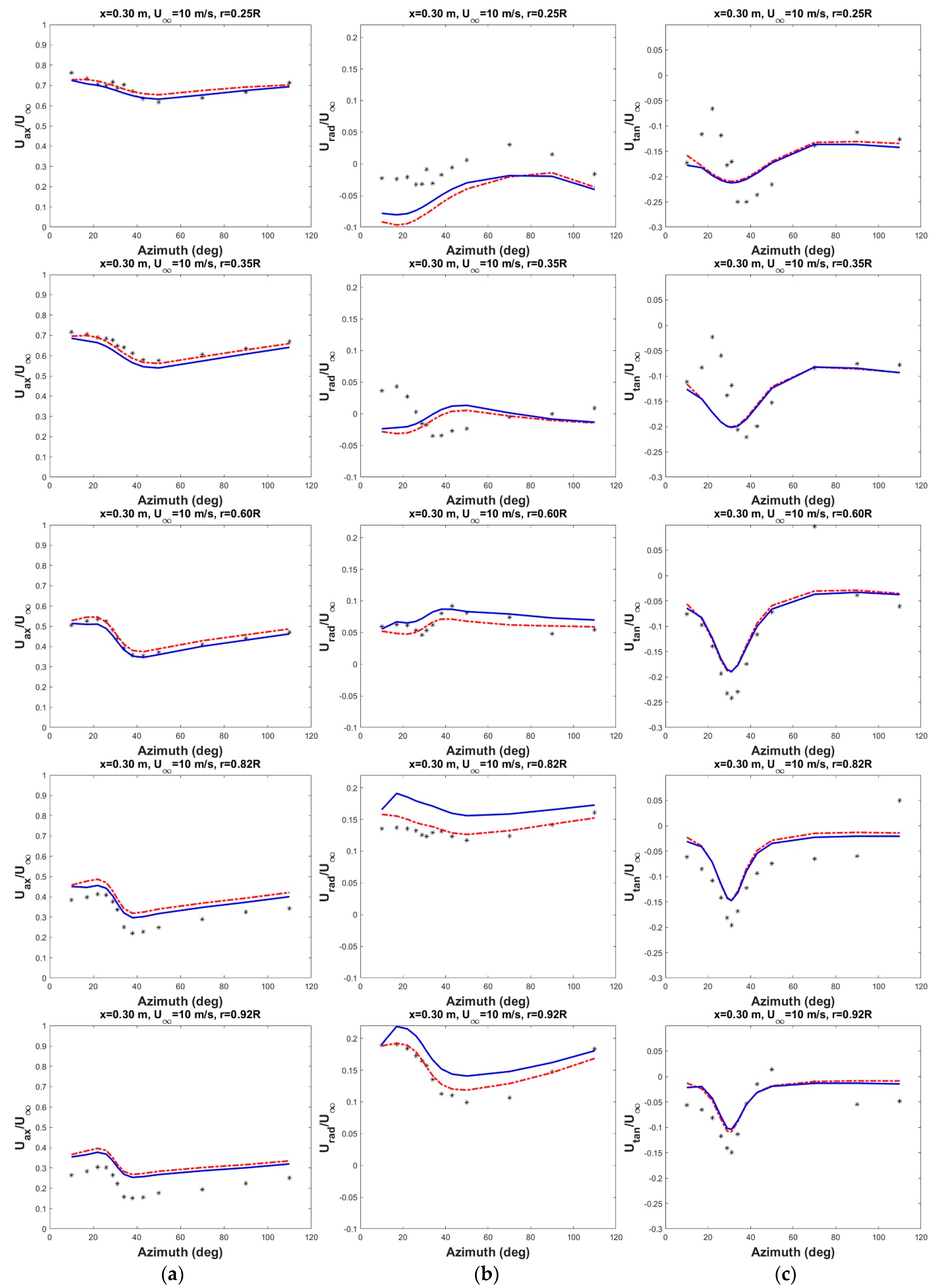
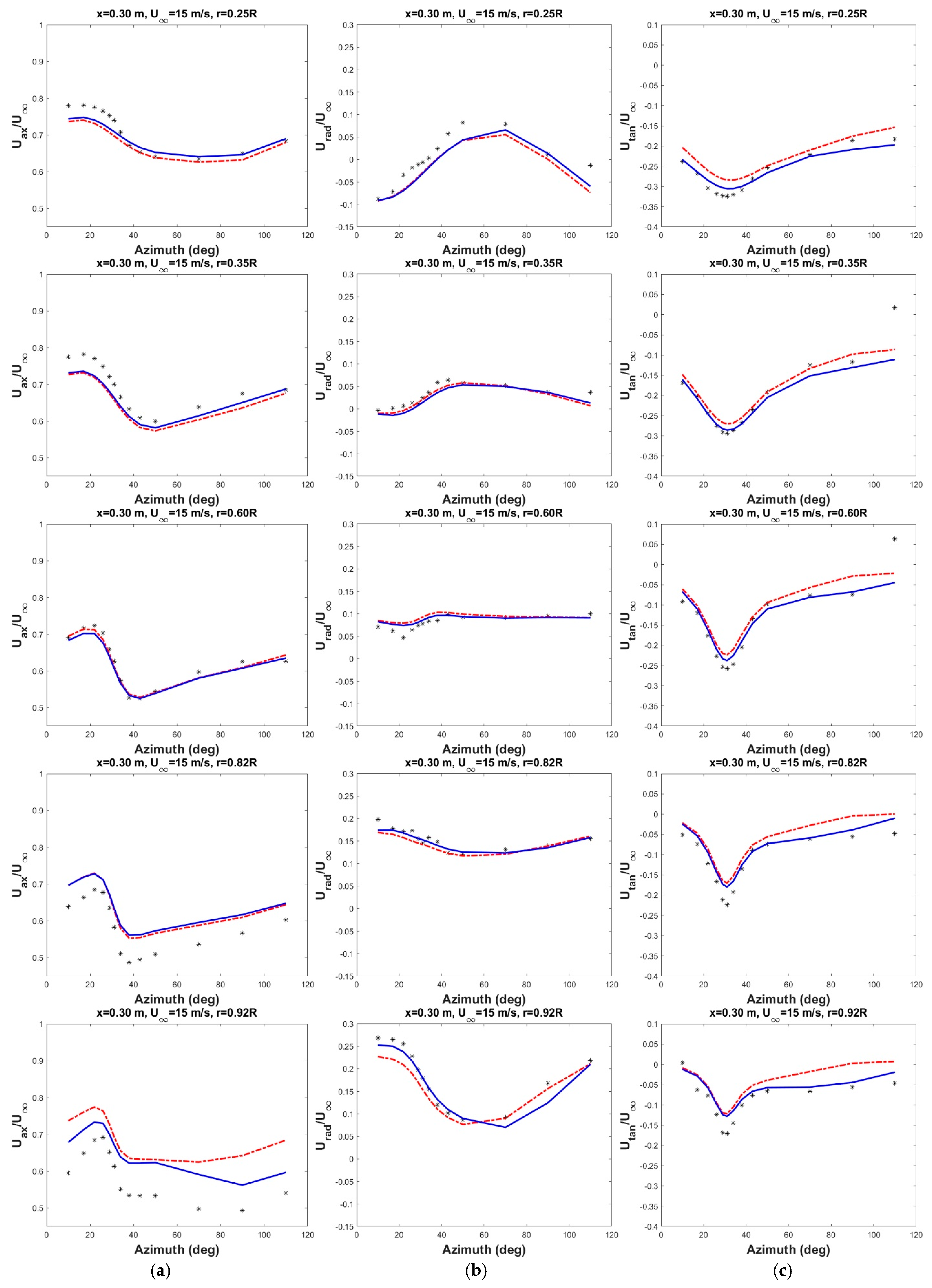
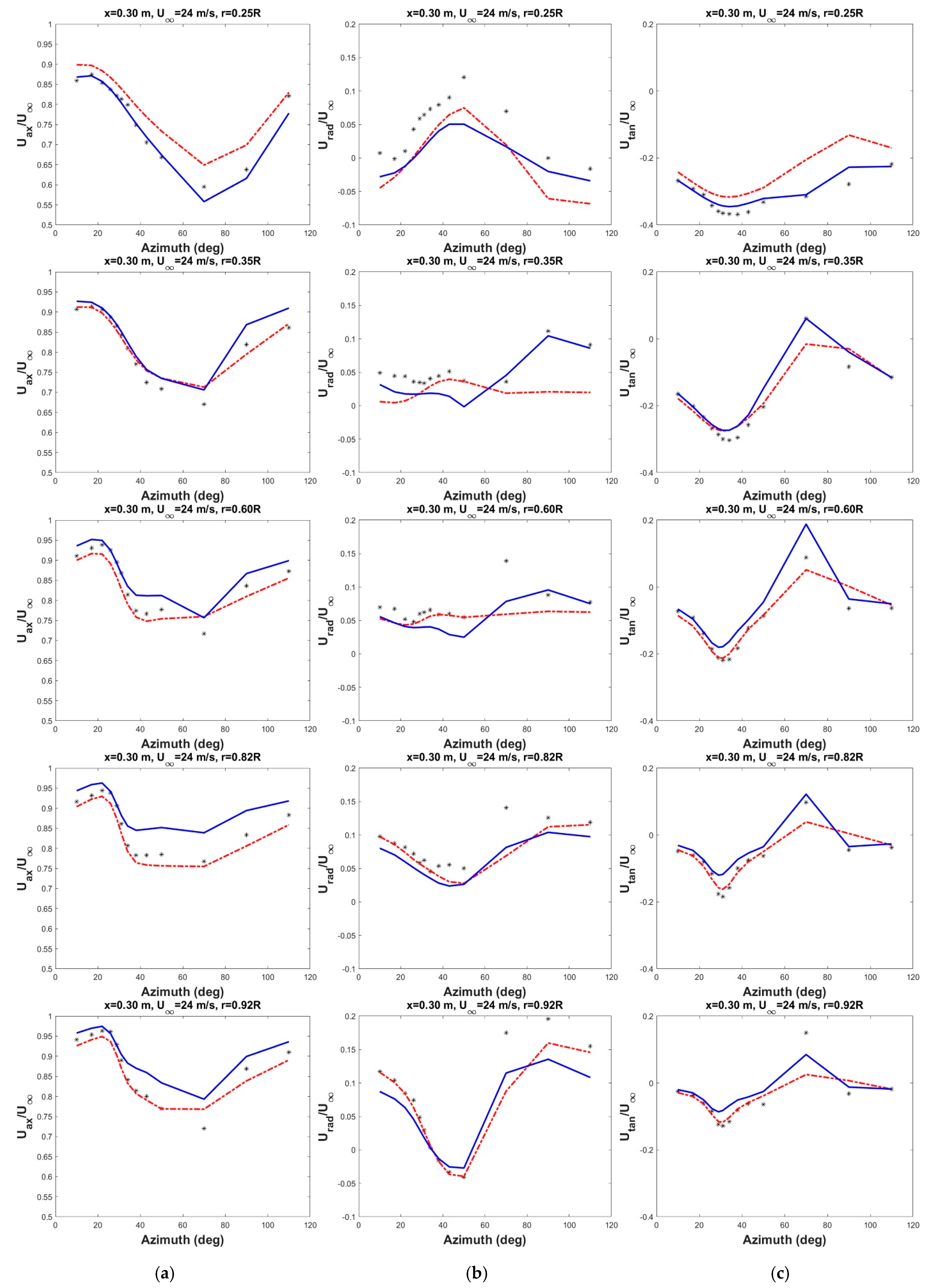
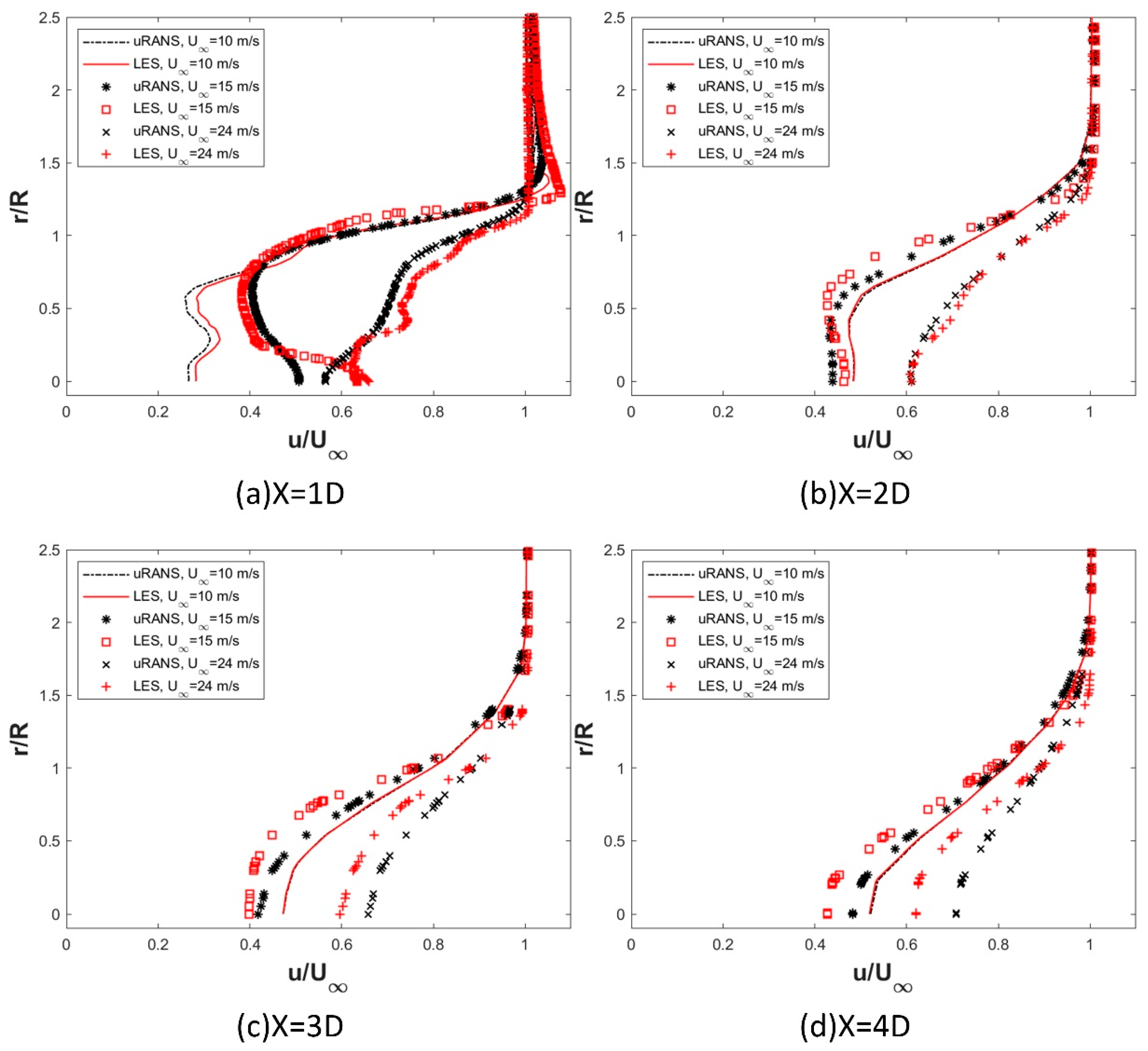
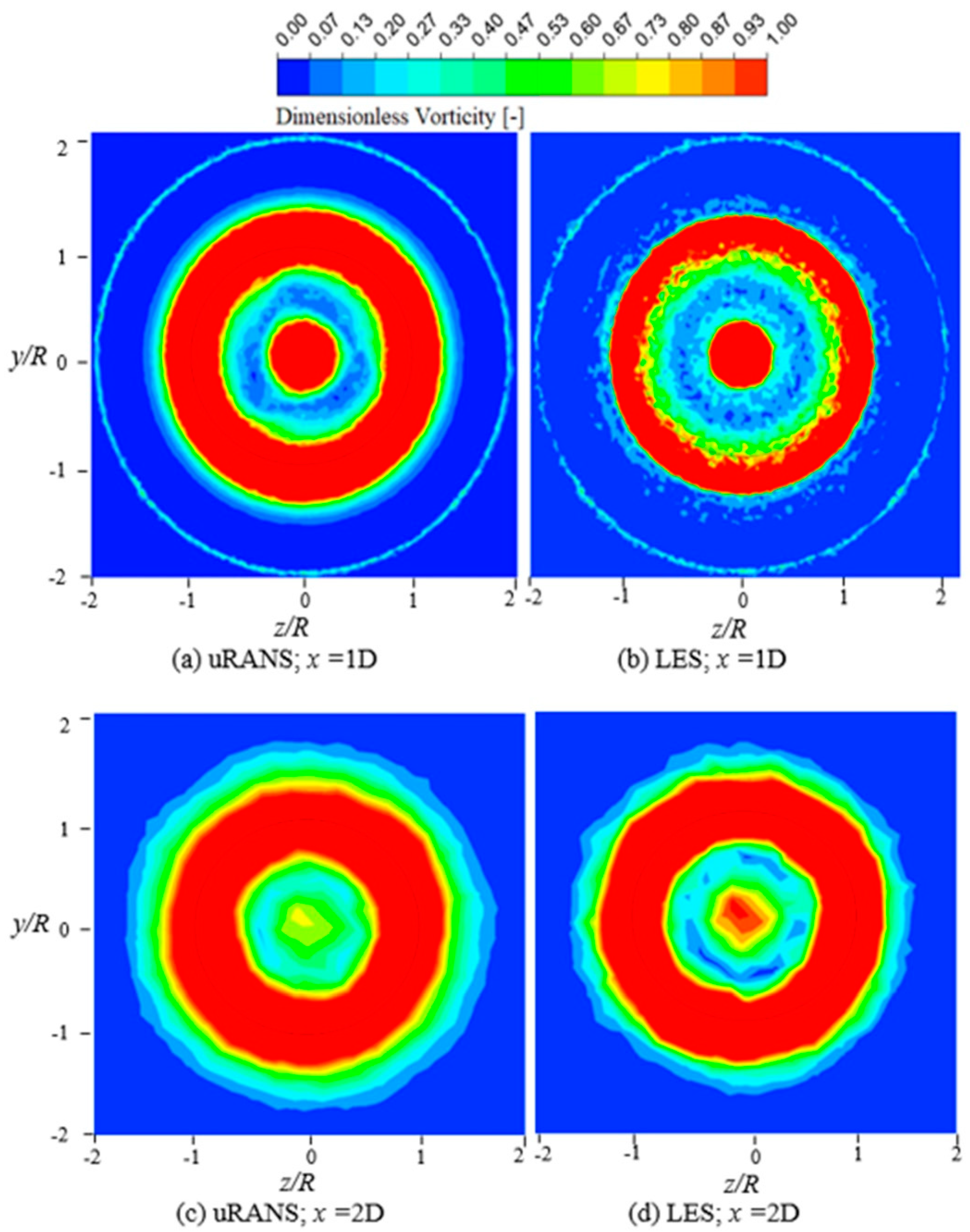


Publisher’s Note: MDPI stays neutral with regard to jurisdictional claims in published maps and institutional affiliations. |
© 2021 by the authors. Licensee MDPI, Basel, Switzerland. This article is an open access article distributed under the terms and conditions of the Creative Commons Attribution (CC BY) license (https://creativecommons.org/licenses/by/4.0/).
Share and Cite
Purohit, S.; Kabir, I.F.S.A.; Ng, E.Y.K. On the Accuracy of uRANS and LES-Based CFD Modeling Approaches for Rotor and Wake Aerodynamics of the (New) MEXICO Wind Turbine Rotor Phase-III. Energies 2021, 14, 5198. https://doi.org/10.3390/en14165198
Purohit S, Kabir IFSA, Ng EYK. On the Accuracy of uRANS and LES-Based CFD Modeling Approaches for Rotor and Wake Aerodynamics of the (New) MEXICO Wind Turbine Rotor Phase-III. Energies. 2021; 14(16):5198. https://doi.org/10.3390/en14165198
Chicago/Turabian StylePurohit, Shantanu, Ijaz Fazil Syed Ahmed Kabir, and E. Y. K. Ng. 2021. "On the Accuracy of uRANS and LES-Based CFD Modeling Approaches for Rotor and Wake Aerodynamics of the (New) MEXICO Wind Turbine Rotor Phase-III" Energies 14, no. 16: 5198. https://doi.org/10.3390/en14165198
APA StylePurohit, S., Kabir, I. F. S. A., & Ng, E. Y. K. (2021). On the Accuracy of uRANS and LES-Based CFD Modeling Approaches for Rotor and Wake Aerodynamics of the (New) MEXICO Wind Turbine Rotor Phase-III. Energies, 14(16), 5198. https://doi.org/10.3390/en14165198






